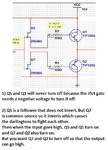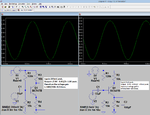Audioguru
Advanced Member level 7
- Joined
- Jan 19, 2008
- Messages
- 9,457
- Helped
- 2,151
- Reputation
- 4,302
- Reaction score
- 2,008
- Trophy points
- 1,393
- Location
- Toronto area of Canada
- Activity points
- 59,719
It is about 1.4V when it has no load. The datasheet shows a maximum of 2.5V when it has a load.My totem pole is an emitter follower where the Vout is Vin - 1.4 in the case of a darlington transistor
Emitter-followers never saturate!I want enough base current to saturate the darlingtons in this situation
The collector to emitter voltage is never as low as a saturated common-emitter transistor or darlington. So it has the same minimum current gain of 1000 as a linear circuit. The base current is 3mA maximum with a 3A load.
If the emitter is grounded and the load is connected from the collector to the positive supply then it is a common-emitter darlington that needs a base current of maybe 20mA to saturate with a 3A load. The datasheet shows it saturating poorly with a 12mA base current.
But you are saying that the AND cannot supply it without overheating. And even if it could supply the required 12mA, it can't do it at 15V[/quote]
What is the voltage swing and maximum current that you need from this circuit? I saw your load of 2 ohms but saw impossible voltages and many different maximum currents on your simulations.
The IC is designed to do what you want, why not use it?So then how is it possible to replicate the functionality of a UCC27425, with its Vin and Venable, using logic gates?


